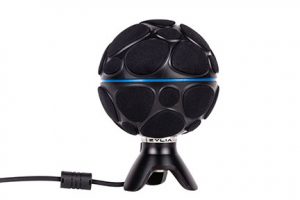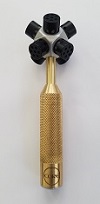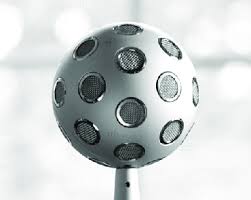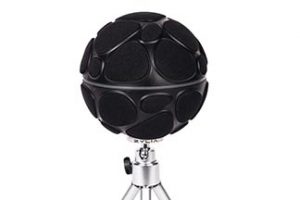 I have gotten behind in my blog posts recently because I have been very busy. One of the most interesting things keeping me busy is discovering ambisonic recording. As a recordist who often records live concerts (mostly classical), this is a near-ideal way to record without spending a huge amount of time on setup and without having to engage the musicians for extra setup time. I often work with New York City professional artists who need to be paid for their time, whether it is a rehearsal, a concert, or—alas—a microphone test.
I have gotten behind in my blog posts recently because I have been very busy. One of the most interesting things keeping me busy is discovering ambisonic recording. As a recordist who often records live concerts (mostly classical), this is a near-ideal way to record without spending a huge amount of time on setup and without having to engage the musicians for extra setup time. I often work with New York City professional artists who need to be paid for their time, whether it is a rehearsal, a concert, or—alas—a microphone test.
Ambisonics is a method of recording that can capture a total acoustical environment in 360-degree space (think of a sphere). It divorces the recording process from the playback process. After recording in ambisonic mode the resulting file can be converted into 5.1 or four-speaker surround sound, stereo, binaural, etc. We shall see that this offers some amazing advantages.
The process has been around for some time. It started with the invention of the SoundField microphone in the late 1970s. In that mic there were four directional capsules arranged in a tetrahedron shape. (The image at the left shows the Rode SoundField mic which is similar to the original Calrec mic of the 1970s.)  This allows sound to be picked up with directional cues beyond simply left or right, but including up and down, back and front, etc.
This allows sound to be picked up with directional cues beyond simply left or right, but including up and down, back and front, etc.
In what is often called minimalist stereo mic placement, two mics pick up the left and right aspects of a sound (using one of several common placement methods), which correspond to the left and right speakers in playback. Such a stereo recording can be directly fed to two speakers.
In ambisonic recording the recording itself must be processed before playback as a stereo file, a surround file, a binaural recording, etc. In the days before cheap, powerful desktop and laptop computers this required an expensive processing box. The earliest, and thus the most famous (in its day), was the Calrec SoundField microphone, but it cost thousands of dollars. Nevertheless, it offered enough advantages that at least one classical label, Nimbus, made almost all of its recordings using that mic and releasing the recordings in what was called “Ambisonic UHJ Format,” released as two-channel stereo records. I have a recording of the English Chamber Orchestra on Nimbus that shows a picture on the back of the small ensemble with the single SoundField mic hanging roughly over the head of the conductor. The sound and performance are both excellent.
Of course the label could have recorded the ensemble with a stereo pair or, for maximum flexibility, with a separate mic for each instrument or group of instruments, and mixed the result down to stereo. That adds lots of time and gear but can work for a dedicated recording session without an audience. But in a concert situation a stage cluttered with mics can be a distraction, especially in a setting, such as an old cathedral, where the visual impact of the environment adds to the enjoyment by the audience.
With the advent of computers capable of sound recording and processing, and small multi-track recorders, it has become possible to build ambisonic mics that are less costly and don’t need a special processing box (other than a computer). One of the first such mics was the Core Sound Tetramic, which resembles the original Calrec SoundField mic but with slightly smaller capsules. It currently costs about $1,400, and I have talked to classical recordists who have been very happy with the results. Rode is now introducing a similar mic for $999. It is new but Rode has a good reputation as a microphone company.
However, the story does not end here. There are several “orders” of ambisonics and the mics I have talked about so far are all first-order mics. If one builds mics with more capsules, one can achieve second-, third-, and even fourth-order ambisonics. The higher orders provide even better localization of sound within the sound field and a larger “sweet spot” for listening and can accurately pick up sounds farther from the mic. But if one wants higher orders, the mics have to be built with more capsules and the resulting multiple signals require more recording channels.
 Core Sound is introducing its OctoMic (under $2,000) with eight capsules, capable of second-order ambisonics. Core Sound has been a very innovative small company, so I expect this will be a good product.
Core Sound is introducing its OctoMic (under $2,000) with eight capsules, capable of second-order ambisonics. Core Sound has been a very innovative small company, so I expect this will be a good product.
At the high end, a popular mic is the EigenMike having 30 capsules and capable of even fourth-order ambisonics. It is small and round, (see image) but its biggest drawback for me is that it costs $20,000. If I win the lottery . . . hmm.
having 30 capsules and capable of even fourth-order ambisonics. It is small and round, (see image) but its biggest drawback for me is that it costs $20,000. If I win the lottery . . . hmm.
 The ambisonic mic I currently own looks similar to the EigenMike and is made by Zylia, a Polish company. It has gotten much press and good reviews because of its low cost (under $1,000). It has “only” 19 capsules and can do third-order ambisonics. In my view this mic represents very good value in terms of performance and cost.
The ambisonic mic I currently own looks similar to the EigenMike and is made by Zylia, a Polish company. It has gotten much press and good reviews because of its low cost (under $1,000). It has “only” 19 capsules and can do third-order ambisonics. In my view this mic represents very good value in terms of performance and cost.
WOW! What can one do with the Zylia? In full ambisonic mode it records 19 channels of digital audio, 48k sampling rate and 24-bit resolution; then this file can be processed in Zylia’s own software plugin using a standard DAW—most people using the mic seem to use Reaper as their Digital Audio Workstation (DAW)—to create a stereo, surround, binaural, etc., final result. (Keep in mind that binaural uses only two channels but has much better imaging than stereo, though it must be listened to with headphones or crosstalk-canceled speakers, unlike stereo.)
I first saw and heard the Zylia on the convention floor of the Audio Engineering Society (AES) National Convention in 2017. They had hired three jazz musicians who were arranged in a triangle, each at least six feet or more from the spherical mic (about the size of an American softball). The mic had been calibrated so each musician could be, in the DAW, on a separate track as if close mics had been used. What amazed me was after they made the recording and processed it in the DAW one could use faders to balance and pan the musicians to produce a stereo result. But in listening to the musicians the very noisy environment of the trade show floor was reduced to almost nothing. Certainly the sound was as good as if each musician had been playing into a separate cardioid mic about 18 inches from their instrument. Yet the Zylia mic was not very close.
The Zylia software provides a way to “calibrate” the mic as if using separate mics by having each musician play a bit separately. This is fine when one can work with musicians separately before a concert, but I noted earlier that I often record classical concerts where the musicians would expect payment for mic tests. BUT by recording all 19 separate ambisonic channels one can “place” virtual mics after the recording has been made. Read that again if it sounds impossible. But this is what the Zylia can do. Thus I can walk into a concert hall, place the single mic without knowing for sure which performers have solos or when, and later adjust virtual mics to sound like individual mics had been placed—a real godsend to the classical concert recordist.
Although I ordered my Zylia in October of 2017, they were still developing the final version, so I did not receive mine until October 2018, just 10 days before the 2018 AES convention. But Zylia put on a workshop at that convention that included a demo that blew me away. Somebody had recorded some kind of chamber opera with singers and orchestra and planned to either release it on CD or broadcast it (I can’t remember). But after they made the recording they found out that although they had permission to distribute the singers’ performances they could not use the orchestra sound. Keep in mind the whole thing had been recorded with a single Zylia ambisonic mic. They were able to strip out the orchestra music—even demonstrating how the singers sounded without the orchestra (which was at that point simply part of the noise floor) and replace the orchestra parts by recording a new orchestra in sync with the singers!
I am also involved with soundscape recording—the recording of natural acoustic environments, either in nature or in urban areas. The Zylia mic is also good for that and even comes with a furry windscreen for outdoor use.
This is a new era for The Sandbook Studio, and your Audio Penguin is intrigued. I have two ambisonic music recordings scheduled for clients in December and am now working to master the software. For those interested in technical affairs, the connection between the Zylia mic and the computer is by USB cable—very simple, reliable, and straightforward.
As I get more experience with the system I may post more. For those looking for additional information, I have posted some links below. The theory of ambisonics involves lots of math. In June 2017 I took a half-day workshop in ambisonic theory and practice at Penn State University as part of the International Conference on Auditory Display (of which I was president for four years). They went over the math in detail but I have included a link that shows the math for those with a math background. Although the math intrigues me, one does not have to be a math whiz to use ambisonic mics and software… so don’t get scared.
https://flo.mur.at/writings/HOA-intro.pdf
This is a link to a paper about high-order ambisonic theory (some high math).
https://www.zylia.co/white-paper.html
This is information from Zylia about ambisonics (less math than above).
Here are links to the products mentioned:
Core Sound: https://www.core-sound.com/default.php
Rode: https://www.rode.com/
Zylia: https://www.zylia.co/
EigenMike: https://mhacoustics.com/products
Good luck and I await reader comments and questions.
Eric
Fascinating!
This was very helpful. Trying to decide if I want to dig in and do some experiments.
Dear Eric,
thank you for this contribution!
Do you by any chance know – who is holding the rights for the logo of ambisonics?
The one, we see here on the wikipedia site: https://en.wikipedia.org/wiki/Ambisonics#/media/File:AmbisonicLogo.svg
Thank you very much and cheers,
Agnes
I have not seen that logo used much for ambisonics. But I see from research that it is out of copyright (now in public domain) so it would not be good to use in the context of a business ID as anyone could legally copy it. But it might serve a purpose if distrbuting ambisonic files to identify the content as ambisonic.
Great post! Thank you for sharing information about ZYLIA!
Greetings from Poland from Zylia Team:-)